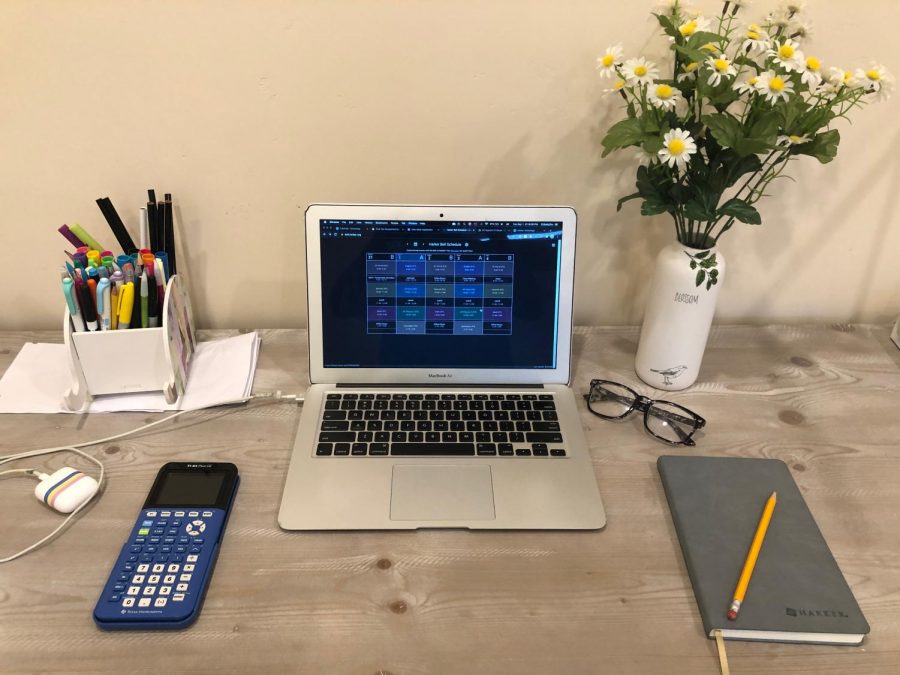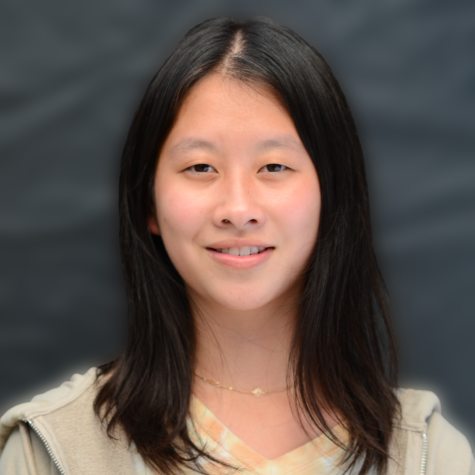Upper school implements bell schedule changes and Zoom guidelines for remote learning
The first semester of the 2020-2021 school will utilize a modified two-day rotation block schedule. This is in response to limitations from the COVID-19 pandemic, prompting Governor Gavin Newson to issue a directive to all schools to begin the year exclusively through remote learning.
September 2, 2020
The upper school has adopted a modified bell schedule for the first semester of the 2020-2021 school year. All instruction will be taking place online due to the COVID-19 pandemic, prompting the administration to release new Zoom guidelines for remote learning last week, helping students balance screen time and optimize productivity.
A two-day rotation block schedule has replaced the former four-day rotation, and more frequent designated break periods have been placed in the schedule. The administration’s newly released Zoom etiquette protocol involves designating a prepared workspace, muting microphones when not speaking, closing other unrelated tabs and applications and using Harker-approved virtual backgrounds.
The online teaching format follows Harker’s suspension of all classes and extracurricular events in March, when Santa Clara County and California public health officials limited the size of gatherings to reduce community spread of COVID-19. Until the county is taken off the state’s COVID-19 watchlist, large gatherings will continue to be restricted, and schools may not take steps towards re-opening unless they obtain a waiver. Once the county is off of the state’s watchlist for 14 days, schools may resume in-person instruction and activities consistent with requirements issued by the Public Health Department.
Teachers have been encouraged to employ a 30-20-30 approach, with 30 minutes of lecture followed by 20 minutes of off-screen break time, and another 30 minutes of lecture time so that both students and teachers can take time to recharge and focus. However, administrators understand that this scheme is flexible.
“If 30 minutes comes and you guys are in the middle of a great discussion, we don’t ever want a teacher to say, ‘Oh, well, I’m sorry, you need to go off screen now,’” upper school Academic Dean Kelly Horan said. “We want to be able to honor that momentum. But at the end of that… there needs to be some broken up time so that we can take a little brain break, recharge, and then come back and be able to focus.”
In order to create a more interactive, engaging classroom experience, many teachers, including upper school history teacher Byron Stevens, participated in a weeklong “Design Bootcamp” to learn more about implementing courses in remote format.
“[I was thinking,] how do I build community and connection among students that I’m meeting for the first time online?” Stevens said. “One of my big takeaways from the Design Bootcamp was the need to elevate faces and voices to see your classmates … not just when you’re in a synchronous Zoom call, but outside of class, asynchronously as well.”
Like other teachers, he has explored different websites and tools to keep students connected and engaged. He is currently experimenting with Flipgrid, a website where students and teachers can record and edit short video responses, and Schoology discussion threads with audio and video recording improvements.
Teachers have also taken measures in order to create a fair testing space and to prevent cheating. For example, AP Chemistry teacher Dr. Mala Raghavan will be employing a “second camera setup” that shows both the student’s desk and laptop screen to ensure they are taking the test independently. Furthermore, AP United States History teacher Julie Wheeler is giving tests with more stimulus-based instead of fact-based questions to encourage students to actively think instead of simply referring to their notes.
While creating the new block schedule, Harker administrators designated an activity period to encourage relaxation and bonding. They worked to balance instructional time with off-screen breaks, keeping in mind that students need enough time to learn the material, but also enough break periods so they can stay focused and make the most of the lecturing time.
“That activity block was really important to factor in some of the school routines. Another consideration is how much office hours [there are], since students need a little bit more individual attention,” Horan said. “I think you’ll notice that the time for Office Hours has actually increased through the week, and we’ve also tried to balance a full week of classes with the next week having a day off in some way.”
So far, returning high school students have found the new block schedule to be more effective in balancing learning and relaxation time.
“I think last year was a little stressful, and the reason was that we had a lot of breaks, but the breaks were shorter. And here, we have less breaks but they’re longer,” said Harshil Garg (11). “Also, office hours are longer, with 40 minute periods, so I can get more thorough help from my teachers.”
These changes have made a big difference from the previous school year, when instructors had to quickly adapt to remote teaching. Shayla He (9) noted that not only have classes become more interactive, but students are more willing to speak up.
“Last year during remote learning, most of my classmates would be off camera and working individually, or you’d be in a breakout room and no one would know what to do,” she said. “This year, people in the breakout rooms are holding discussions, and we’re talking more in class too.”
While online classes are not a typical start to the school-year, Zoom classes have served to be a welcoming space for incoming freshmen like Shayla.
“I never expected that I would start out high school like this during coronavirus… I’m just looking forward to meeting all [the other students], and we’re very excited about that,” Shayla said.
Ultimately, Harker intends these new guidelines to provide the best possible learning and community environment for all the students in this unique school year.
“I think the ultimate goal is making the classroom and our school environment an inclusive place for all people, and also all learners. If a person feels safe in a classroom, they’re going to take risks… and we only learn really by making mistakes,” Horan said. “I think a lot of times all of us as learners are afraid to fail in front of our peers. And so we want to create a safe space where everybody feels like it’s okay to give that answer to the math problem, even if they’re not 100% sure that they’re right.




![LALC Vice President of External Affairs Raeanne Li (11) explains the International Phonetic Alphabet to attendees. "We decided to have more fun topics this year instead of just talking about the same things every year so our older members can also [enjoy],” Raeanne said.](https://harkeraquila.com/wp-content/uploads/2025/10/DSC_4627-1200x795.jpg)


















![“[Building nerf blasters] became this outlet of creativity for me that hasn't been matched by anything else. The process [of] making a build complete to your desire is such a painstakingly difficult process, but I've had to learn from [the skills needed from] soldering to proper painting. There's so many different options for everything, if you think about it, it exists. The best part is [that] if it doesn't exist, you can build it yourself," Ishaan Parate said.](https://harkeraquila.com/wp-content/uploads/2022/08/DSC_8149-900x604.jpg)




![“When I came into high school, I was ready to be a follower. But DECA was a game changer for me. It helped me overcome my fear of public speaking, and it's played such a major role in who I've become today. To be able to successfully lead a chapter of 150 students, an officer team and be one of the upperclassmen I once really admired is something I'm [really] proud of,” Anvitha Tummala ('21) said.](https://harkeraquila.com/wp-content/uploads/2021/07/Screen-Shot-2021-07-25-at-9.50.05-AM-900x594.png)







![“I think getting up in the morning and having a sense of purpose [is exciting]. I think without a certain amount of drive, life is kind of obsolete and mundane, and I think having that every single day is what makes each day unique and kind of makes life exciting,” Neymika Jain (12) said.](https://harkeraquila.com/wp-content/uploads/2017/06/Screen-Shot-2017-06-03-at-4.54.16-PM.png)








![“My slogan is ‘slow feet, don’t eat, and I’m hungry.’ You need to run fast to get where you are–you aren't going to get those championships if you aren't fast,” Angel Cervantes (12) said. “I want to do well in school on my tests and in track and win championships for my team. I live by that, [and] I can do that anywhere: in the classroom or on the field.”](https://harkeraquila.com/wp-content/uploads/2018/06/DSC5146-900x601.jpg)
![“[Volleyball has] taught me how to fall correctly, and another thing it taught is that you don’t have to be the best at something to be good at it. If you just hit the ball in a smart way, then it still scores points and you’re good at it. You could be a background player and still make a much bigger impact on the team than you would think,” Anya Gert (’20) said.](https://harkeraquila.com/wp-content/uploads/2020/06/AnnaGert_JinTuan_HoHPhotoEdited-600x900.jpeg)

![“I'm not nearly there yet, but [my confidence has] definitely been getting better since I was pretty shy and timid coming into Harker my freshman year. I know that there's a lot of people that are really confident in what they do, and I really admire them. Everyone's so driven and that has really pushed me to kind of try to find my own place in high school and be more confident,” Alyssa Huang (’20) said.](https://harkeraquila.com/wp-content/uploads/2020/06/AlyssaHuang_EmilyChen_HoHPhoto-900x749.jpeg)










